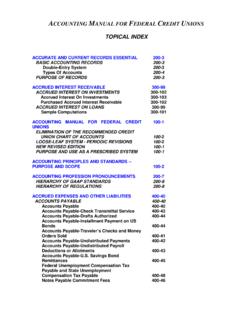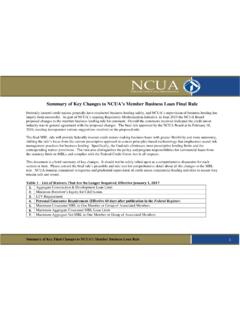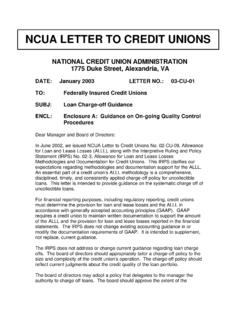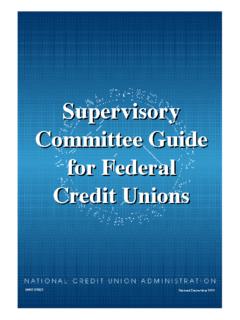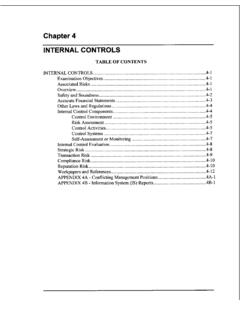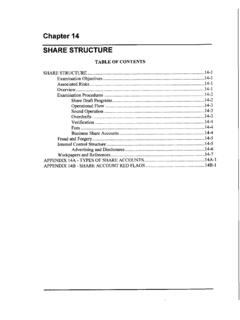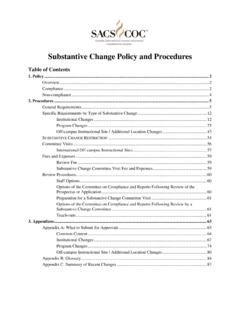Transcription of Chapter 18 REGULATORY COMPLIANCE - National Credit …
1 Chapter 18 REGULATORY COMPLIANCE TABLE OF CONTENTS REGULATORY COMPLIANCE .. 18-1 Examination Objectives .. 18. 1 Associated Risks .. Overview .. 18-1 Examination Procedures .. 18-1 Charter and Bylaws .. 18-2 Security Pro gram .. 18-2 Safeguarding Member Information .. 18-3 Margin Securities .. 18-4 Records Preservation .. 18-4 Call Reports .. 18-4 Incidental Powers .. 18-5 Interest Rate Limitation .. 18-5 Appraisals .. 18-5 Federal, State and Local Reporting Requirements .. 18-5 Regulation D .. 18-8 Additional Information .. 18-8 References .. 18-8 APPENDIX 18A Bank Secrecy Act (BSA) .. 18a-1 APPENDIX 18B REGULATORY Flexibility Program (Reg Flex) .. 18B-1 ATTACHMENT - Money Laundering Red Flags .. A1 17 Chapter 18 REGULATORY COMPLIANCE Examination Objectives 0 Determine whether the Credit union assesses and mitigates risks ( , through surety bond rider, internal audits, etc.)
2 Initiate corrective action to resolve deficiencies in practices, policies, or procedures as well as violations of statute and regulation Associated Risks and lawsuits; 0 COMPLIANCE - the risk that failure to comply can result in penalties Strategic risk -the current and prospective risk to earnings or capital arising from adverse business decisions, improper implementation of decisions, or lack of responsiveness to industry changes; and Reputation risk - the risks that the Credit union cannot meet member loan and share funding requests, causing concerns about the Credit union s solvency. 0 Overview NCUA s Rules and Regulations along with other regulations that apply to Credit unions ( , regulations issued by the Federal Reserve Board) form REGULATORY COMPLIANCE . The amount of examination time spent on a specific COMPLIANCE area will depend on the amount of risk identified in that area.
3 Examination Examiners should: Procedures 0 Obtain and review the Credit union s REGULATORY COMPLIANCE program; Review the system of internal controls to ensure on-going COMPLIANCE ; Ensure the Credit union completed independent testing of the program; 0 Page 18-1 EXAMINER'S GUIDE Determine Credit union designated an individual responsible for coordinating and monitoring day-to-day COMPLIANCE ; and Review the training provided to appropriate personnel. 0 Examiners should discuss emerging or unresolved deficiencies with management and, if material deficiencies exist, they should include a discussion in the examination report. Charter and Bylaws The Credit union's charter sets forth the field of membership ( , who the Credit union may accept as members.) The Credit union must seek approval from the regional director for any amendments to the charter (name change, field of membership change, etc.)
4 Examiners may review the current field of membership and the Credit union's procedures to ensure that only the individuals within those groups named in the charter are accepted as members. Each Credit union board adopts a set of bylaws, under which the Credit union operates. These may consist of a combination of pre-approved bylaws, options, and standard amendments. Additionally, Credit unions may obtain approval for nonstandard bylaw amendments if they meet certain criteria. Thus, the Credit union has the responsibility to maintain a current and complete set of its own bylaws. The bylaws function as a contract between the Credit union and its members. Although Credit unions must permit members to review the Credit union's bylaws on request, they need not provide members with a copy of the bylaws.
5 Security Program Part 748 of the NCUA Rules and Regulations establishes minimum security standards and procedures for Credit unions. Examiners should determine that the Credit union (1) established an adequate security program in accordance with the regulation, and (2) updates the program to reflect operational changes. Management must provide adequate safeguards to: 0 Protect the Credit union from robberies, burglaries, larcenies, and embezzlement; Ensure security and confidentiality of member records; 0 Page 18-2 REGULATORY COMPLIANCE Assist in identification of persons who commit or attempt such actions and crimes; and Prevent destruction of vital records (as defined by Rules and Regulations Part 749.) The Credit union's security program must include administrative, technical, and physical safeguards appropriate to the size and complexity of the institution and the nature and scope of its activities.
6 At a minimum, Credit union management should design and implement a comprehensive written security program to: Identify key controls, systems, and procedures; Assess internal and external threats; Assign responsibilities; Establish security procedures consistent with operating systems; Provide periodic training of all employees; Protect against destruction, loss, or damage of information, and develop recovery procedures; Ensure periodic testing of the security program; Re-assess threats and the adequacy of controls; Review monitoring systems and control procedures; and Revise strategies. Examiners may evaluate management's efforts to identifl, assess, measure, mitigate, and monitor risks. Safeguarding Member Information Appendix A of Part 748 of the NCUA Rules and Regulations provides guidance standards for developing and implementing administrative, technical, and physical safeguards to protect the security, confidentiality, and integrity of member information.
7 Safeguarding member information requires a written comprehensive program that includes administrative, technical, and physical safeguards appropriate to the size and complexity of the Credit union and the nature and scope of its activities. The Credit union should design the program to: Page 18-3 EXAMINER S GUIDE 0 Ensure the security and confidentiality of member information; Protect against anticipated threats or hazards to the security or integrity of such information; and Protect against unauthorized access to or use of such information that could result in substantial harm or inconvenience to any member. Examiners may evaluate management s efforts to identify, assess, measure, mitigate, and monitor risks. Margin Secu ri t ies When margin securities secure loans, federal Credit unions must follow the provisions of Regulation U, Credit by Banks or Persons Other Than Brokers or Dealers for the Purpose of Purchasing or Carrying Margin Stocks, and the Credit union members are subject to provisions of Regulation X, Rules Governing Borrowers Who Obtain Securities Credit , issued by the Federal Reserve Board.
8 These regulations help curb excessive Credit in the securities market. Regulation U generally applies to the lender, whereas Regulation X applies to the borrower. Records Preservation Part 749 of NCUA Rules and Regulations (Vital Records Preservation) permits Credit unions to preserve records in electronic form in COMPLIANCE with the Electronic Signatures Global and National Commerce Act. The rule also permits a Credit union s board to determine which employee will assume responsibility for storing vital records under the records preservation program, and incorporates an appendix with suggested guidelines on retention periods for various records. Call Reports All federally insured Credit unions must file quarterly call reports. It is essential that each Credit union files the call reports on time and assumes responsibility for the material accuracy of the reports.
9 Examiners should address the Credit union s failure to submit an accurate call report on a timely basis with the officials and, depending on the circumstances and materiality, in the examination report. Examiners may address repeat or material exceptions in the Document of Resolution. Page 18-4 REGULATORY COMPLIANCE Incidental Powers Interest Rate Lim i tat ion Appraisals Federal, State and Local Report i ng Requirements The Incidental Powers regulation (Part 721, NCUA Rules and Regulations) authorizes federal Credit unions to engage in activities incidental to their business. The regulation provides examples of permissible activities (such as certification services and finder activities) and information on how to request a legal opinion on the permissibility of activities not listed. (5)(A)(vi) of the FCUAct and (~)(7) of the NCUA Rules and Regulations specifj that the rate of interest on a loan may not exceed 15 per centum per mum on the unpaid balance (inclusive of all finance charges) unless the NCUA Board establishes a higher ceiling.
10 The NCUA Rules and Regulations reflect the NCUA Board's establishment of a higher rate, currently 18 percent. Charging a rate of interest in excess of the statutory limitation is generally viewed as usurious. Usury questions typically arise primarily in compensating balances and recomputation for rebates. Part 722 of NCUA Rules and Regulations identifies the real estate- related financial transactions at federally insured Credit unions requiring the services of a state-certified or state-licensed appraiser ( , federally related transactions). Such appraisers must (1) have demonstrated competency, (2) subject their professional conduct to effective supervision, and (3) perform written appraisals in accordance with the Uniform Standards of Professional Appraisal Practice (USPAP). The FFIEC Appraisal Subcommittee monitors states' licensure programs, and maintains a current list of licensed appraisers for each state.
